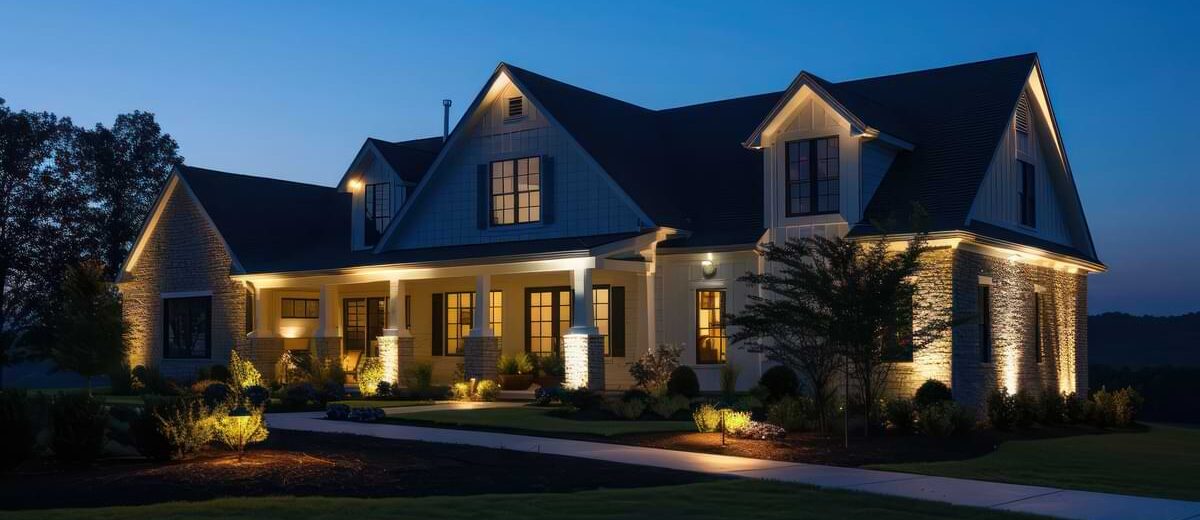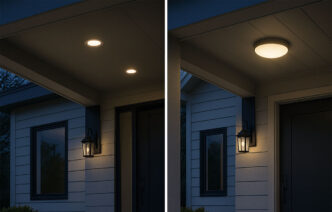Table of Contents: Lumen vs. Candela
Lumens vs. Candelas
When you’re shopping for landscape lighting, you’ll run into two common terms on product labels: lumens and candelas. Both relate to light output, but they measure very different things.
Understanding the difference helps you choose the right fixtures for your yard—whether you want a warm, ambient glow for your garden paths, or a bright, focused beam to highlight a tree or architectural feature.

What Are Lumens?
Lumens measure the total amount of visible light a fixture emits. Think of it as the overall brightness of the bulb, regardless of direction. The higher the lumens, the brighter the light looks.
- Path Lights (100–200 Lumens): Create a soft glow, perfect for safely marking walkways without overwhelming your landscape.
- Flood Lights (1,000+ Lumens): Provide wide, powerful illumination that can cover driveways, patios, or large garden spaces.
When you want to compare the general brightness between fixtures, lumens are your go-to number.
What Are Candelas?
Candelas measure the intensity of light in a specific direction. Instead of looking at the total brightness, candelas tell you how concentrated the beam is at its center.
For example:
- Spotlights (800 Lumens, Narrow Beam): Produces a high candela rating, shining an intense light directly onto a tree, statue, or wall.
- Flood Lights (800 Lumens, Wide Beam): Spreads its light over a larger area, resulting in a lower candela rating.
In short, lumens describe the size of the bucket of light, while candelas show how tightly that light is focused.
Why Both Lumens & Candelas Matter in Landscape Lighting
The best landscape lighting design balances overall brightness (lumens) with beam intensity and direction (candelas). Choosing the wrong measurement to prioritize can lead to either underwhelming or overwhelming results.
- For Pathways and Gardens: Focus on lumens. Low-lumen fixtures (100–300) provide soft, welcoming illumination without glare. Candela ratings aren’t as important here since the light is meant to spread.
- For Accent Lighting: Look at candelas. If you want to draw the eye to a tree, fountain, or architectural detail, the intensity of the beam is what makes the feature pop.
- For Security and Wide Coverage: Balance both. High-lumen fixtures with a moderately high candela rating can cover large areas while still directing light where you need it most.
Comparing Lumen vs Candela for the Right Fixture
When browsing fixtures, you’ll often see both lumen and candela ratings along with the beam angle. Together, these numbers tell the whole story,
| Light Output & Beam Angle | Candela Result | Best For |
| High lumens + narrow beam angle | High candela | Spotlights, highlighting trees, statues, or architecture |
| High lumens + wide beam angle | Lower candela | Flood lights, broad coverage of driveways, patios, or garden areas |
| Lower lumens + wide beam angle | Gentle glow | Path lights, garden beds, and ambient accent lighting |
Lumens vs. Candelas: Fine Tune Your Landscape Lighting Brightness
Lumens and candelas aren’t competing measurements—they work together. Lumens tell you how much light you’re getting, while candelas reveal how that light is distributed.
When planning your landscape lighting design, use lumens to gauge overall brightness and candelas to control focus and mood. Understanding both ensures your outdoor space feels balanced, functional, and beautiful after dark.
FAQs for Lumen vs. Candela
Lumens and candelas actually measure two very different aspects of light that aren’t directly comparable without context. Lumens indicate the total amount of visible light a fixture emits in all directions combined. Candelas, on the other hand, describe how concentrated or intense that light is in a specific direction or beam.
Neither lumens nor candelas are inherently better; each provides useful information depending on what you’re trying to achieve with your lighting. Lumens help you understand the overall brightness a fixture will produce across an area. Candelas tell you how focused and strong the light will appear when aimed at a specific object or feature.
You can convert candelas to lumens, but you need the beam angle to do it correctly. In practice, a narrow beam will feel brighter because the same amount of light is focused into a smaller area, while a wide beam spreads that light more evenly across a space.
Join our Insider list and check out the different lighting options that we have to offer.







